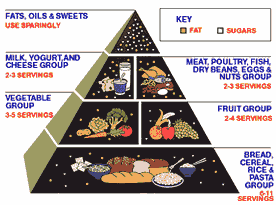HIGH FIBER FOODS
AND YOUR
HIGH FIBER DIET
It's only just begun. The concept of high fiber is starting to take its place within the hearts and mind and mouths of the American public.
Your grandma called it roughage or bulk.
Nutritionists and scientists are recognizing dietary fiber as something more than just a nutrient on our plate. At this time in our evolution, we must be made keenly aware of the health benefits of a high fiber diet.

We have radically changed eating habits in the past 50 years. The average American consumes about 5 to 13 grams of fiber daily, whereas nutrition experts recommend a daily intake of 20-35 grams. Our ancestors' diet was very rich in legumes, fruits, and vegetables which added up to about 100 grams of fiber a day!
It does make one wonder what they did when toilet paper supplies ran out.
We predominately eat proteins and animal fats. This evolution in our diet has prompted illness and disease of the digestive system largely due to the lack of high fiber in our diet.
Here are some of the leading chronic diseases and conditions of our time: diabetes, obesity, diverticulitis, colon cancer and polyps, colitis, high cholesterol, Crohn's disease, IBS, and hemorrhoids.
How do foods high in fiber maximize our health?

Many of these illnesses start during our youth, but symptoms usually don't appear until our 40's or 50's. Yesterday's poor eating habits of low fiber and refined foods means a higher risk for serious conditions later in life such as chronic constipation, diverticulosis, colon cancer, and diabetes.
In addition to improving regularity, consuming adequate amounts of fiber can aid in the prevention of several forms of cancer and heart disease. High fiber diets are helpful in delaying the onset or lowering the risks of many of these diseases.
Sometimes there is confusion as to the difference between crude fiber and dietary fiber. Both are determined by a laboratory analysis, but crude fiber is only one-seventh to one-half of total dietary fiber.
Fiber is found in plants and is generally not digested or absorbed by the body. Many different types of fibers exist and they are grouped into two broad categories. The two general types are soluble fibers and insoluble fibers. Each has a role in promoting and maintaining good health. Getting the right amount of fiber is a struggle for most adults, but the health benefits of fiber make it worth your while. Besides, it will offer a lot more variety to your meals. If you are like me, taking your fiber can be made simple by drinking a fibrous and nutritious morning beverage, such as those available from GreenBarley.com. Try these suggestions for a change:
- Eat more whole grains such as wheat and oats
- As you increase your fiber intake, drink at least 8 glasses of fluids a day
- Fresh fruits and vegetables are the natural choice
- Slowly increase your intake allowing your digestive tract to adjust
- Beans are an excellent source of fiber
- Read package labels to compare fiber content
We have only just begun to understand the amazing benefits of high fiber in our diet, proving once again- you become what you eat. Your health is dependent upon integral changes you need to make to provide a sensible foundation for a lifetime of sound and intelligent eating. Good health is your goal. What more could a body want?
Here is a list of links to many of the major studies on high fiber diets (both the pros and cons) and the government's extensive catalog of fiber related websites.
